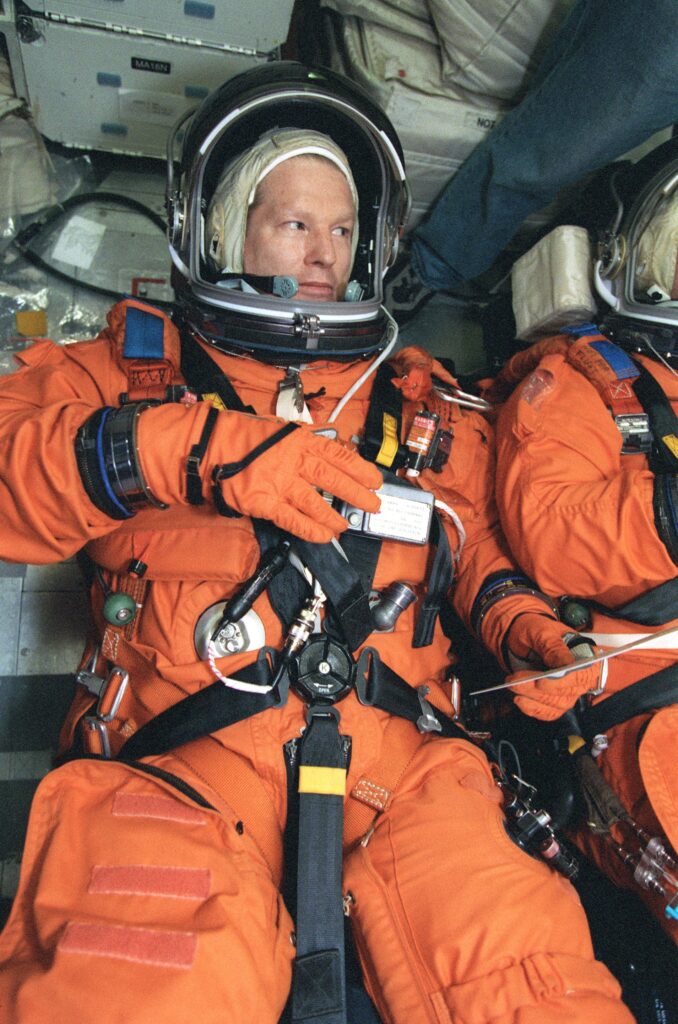William M. Shepherd was born on July 26, 1949, in Oak Ridge, Tennessee, but considers Babylon, New York his hometown. The son of a naval aviator who later worked in the aerospace industry, William graduated from Arcadia High School in Scottsdale, Arizona in 1967. In 1971 he received a Bachelor of Science degree in Aerospace Engineering from the U.S. Naval Academy. He went on to earn a Bachelor of Science degree in Ocean Engineering and a Master of Science in Mechanical Engineering, both in 1978, from the Massachusetts Institute of Technology.
Captain Shepherd intended to become a naval aviator like his father but a vision problem precluded him from becoming a pilot. Instead, he served with the Navy’s elite Underwater Demolition Team ELEVEN, SEAL Teams ONE and TWO, and Special Boat Unit TWENTY. He was selected by NASA to be an astronaut in 1984. His SEAL training proved critical when Shepherd participated in the underwater salvage of the wreckage of the Shuttle Challenger after it exploded during liftoff in January 1986. He was a mission specialist on three shuttle flights from 1988 to 1992, all of which launched from Kennedy Space Center, Florida. From October 31, 2000, to March 21, 2001, Captain Shepherd has commanded the Expedition-1 crew, the first group to occupy the International Space Station (ISS).
On his first space flight, STS-27 (December 2-6, 1988) Shepherd served aboard the Space Shuttle Atlantis. The mission was a top-secret Department of Defense flight during which an advanced Pentagon radar reconnaissance satellite reportedly was deployed in a low Earth orbit. After 105 hours in Earth orbit, Atlantis landed at Edwards Air Force Base, California.
On STS-41 (October 6-10, 1990), the maiden flight of the Space Shuttle Discovery, Shepherd helped deploy the Ulysses spacecraft, starting it on a four-year journey to investigate the polar regions of the Sun. STS-41 made 66 orbits of the Earth, landing at Edwards after 4.09 days in orbit.
William Shepherd’s third mission was STS-52 (October 22 – November 1, 1992), aboard the Space Shuttle Columbia. This flight deployed the Laser Geodynamic Satellite and conducted U.S. microgravity payload experiments while also mapping the Earth by bouncing laser beams off the planet’s surface. After nine days and twenty hours in orbit, the mission ended with a landing at the Kennedy Space Center.
From March 1993 to January 1996, Shepherd was assigned to the Space Station Program, serving in various management positions. In November 1995 he was selected to be on the first full-time crew of the International Space Station (ISS). The mission was supposed to launch in 1997, but a long series of Russian political, financial and rocket problems conspired to delay the flight. Although sixteen nations would participate in the ISS program, Russia, along with the United States would bear the majority of the station’s costs.
On October 31, 2000, Expedition-1 Commander Captain William Shepherd, Soyuz Commander Yuri Gidzenko and Flight Engineer Sergei Krikalev finally lifted off from Baikanor, Kazakhstan aboard a Soyuz rocket. They docked with the International Space Station on November 2. For the next 139 days, they occupied the ISS as its first crew, continuing its construction, then returned to Earth aboard STS-102 Discovery on March 21, 2001. William Shepherd has logged over 159 days in space in his four missions.
Captain Shepherd was next assigned to the staff of Commander, Naval Special Warfare Command, to assist with the development of new capabilities and programs for the SEAL and Special Boat programs. He retired from the Navy in January 2002 to become a civilian engineer.
William Shepherd was awarded the Congressional Space Medal of Honor in 2003, only the thirteenth person to receive that honor, for his command of the first space station crew. He is a member of the American Institute of Aeronautics and Astronautics (AIAA), and has been the recipient of NASA’s “Steve Thorne” Aviation Award.

